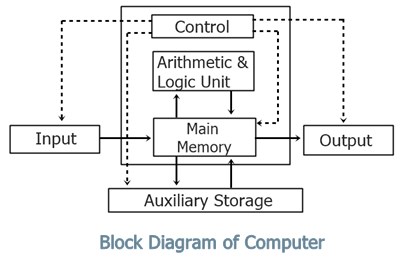- Computer Fundamentals Course
- Computer Fundamentals Tutorial
- Block Diagram of a Computer
- The Generation of Computers
- Types of Computers
- Classification of Computers
- Characteristics of Computers
- Applications of Computers
- Central Processing Unit
- Input Devices
- Output Devices
- Computer Memory and Types
- CD, HD, Floppy, and PenDrive
- Types of Computer Languages
- Types and Language Translator
- Number System with Types
- Decimal to Binary
- Decimal to Octal
- Decimal to Hexadecimal
- Binary to Decimal
- Binary to Octal
- Binary to Hexadecimal
- Octal to Decimal
- Octal to Binary
- Octal to Hexadecimal
- Hexadecimal to Decimal
- Hexadecimal to Binary
- Hexadecimal to Octal
- Algorithm and Flowchart
- Selection Sort
- Insertion Sort
- Bubble Sort
- Linear Search
- Binary Search
- Bitwise Operators
- Binary Number Addition
- EBCDIC & ASCII Code
- BCD, Excess-3, 2421, Gray Code
- Unicode Characters
Block Diagram of Computer with Description
You can get a visual representation of how a computer works on the inside by looking at something called a block diagram of a computer. You could also say that the computer's block diagram will show us how the computer functions, beginning with the input of data and ending with the output of the result.
Here is the block diagram of a computer system:

The "Central processing unit (CPU)" refers to the box depicted in the aforementioned "block diagram" of a computer that contains the control units, the arithmetic and logic unit, and the main memory. I've provided a brief definition of "CPU" here; for more information, please see the dedicated article.
Let's go through each component of the diagram that was just presented by breaking it down piece by piece.
The Central Processing Unit (CPU)
The CPU can be called the brain of a computer system.
The central processing unit (CPU) is where the majority of the important calculations and comparisons are performed. In addition, the CPU is in charge of turning on and controlling the operation of the other units.
The arithmetic logic unit, also known as the ALU, and the control unit (CU) are the two primary elements that make up this unit. First, let's take a moment to briefly define these two different units of CPU.
Arithmetic Logic Unit (ALU)
The arithmetic logic unit is responsible for carrying out all of the mathematical operations, including addition, subtraction, multiplication, and division. In addition to that, a logical operation is used for the comparison.
Control Unit (CU)
In addition, the control unit of a central processing unit is responsible for directing the overall operation of a computer. In addition to this, it exercises control over all devices connected to the CPU, including memory and input/output devices.
The CU is responsible for retrieving instructions from memory, decoding those instructions, interpreting those instructions to determine what tasks are to be carried out, and then sending appropriate control signals to the other components so that they can carry out the steps necessary to execute the instruction.
Input/Output Unit
The input/output unit is made up of different devices that are responsible for transmitting and receiving information between the memory of the computer and the outside world.
The information that is entered into the computer via the input unit is saved in the memory of the device for later processing. The completed processing can then be saved in the memory and either recorded or displayed on the output medium.
Memory Unit
Memory units are an integral part of any modern digital computer. It is the repository for all of the results, both intermediate and final.
The data that are read from the primary storage or an input unit are moved to the memory of the computer so that they can be processed. These data can come from either the main storage or an input unit.
The data that needs to be processed and the instructions that need to be carried out are both stored in this memory unit so they can be accessed quickly.
Disk Storage Unit
Before a computer can begin the process of actually using the data and instructions that it has received from an input device, the data and instructions must first be stored inside the computer.
Primary and secondary storage units are the two categories that can be found in a storage facility. Now let's briefly define these two storage units one by one, starting with the "primary storage unit."
Primary Storage Unit
Primary memory is connected to the input unit as well as the output unit in a straightforward manner. It stores both the data that was input and the result of the calculation.
Secondary Storage Unit
It is not possible to store data permanently on the primary storage for use at a later time. Because of this, additional forms of data storage technology, also known as secondary or auxiliary storage, are required in order to store the data in a manner that is both permanent and accessible over an extended period of time.
« Previous Tutorial Next Tutorial »